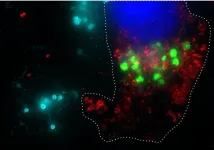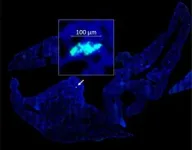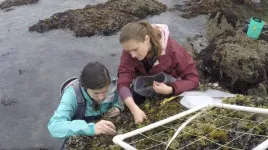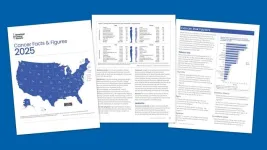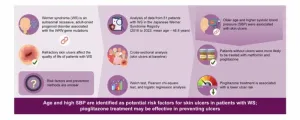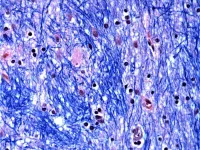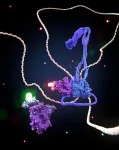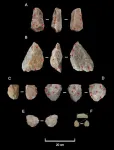(Press-News.org)
A University of Massachusetts Amherst-Ernest Pharmaceuticals team of scientists has made “exciting,” patient-friendly advances in developing a non-toxic bacterial therapy, BacID, to deliver cancer-fighting drugs directly into tumors. This emerging technology holds promise for very safe and more effective treatment of cancers with high mortality rates, including liver, ovarian and metastatic breast cancer.
Clinical trials with participating cancer patients are estimated to begin in 2027. “This is exciting because we now have all the critical pieces for getting an effective bacterial treatment for cancer,” says Neil Forbes, senior author of the research published recently in the journal Molecular Therapy and professor of chemical engineering at UMass Amherst.
“What we’re trying to do is unlock the potential to treat late-stage cancers,” adds lead author Vishnu Raman, who earned his Ph.D. in the Forbes Lab at the UMass Amherst Institute for Applied Life Sciences (IALS). “Bacteria naturally home to tumors and because this treatment is so targeted, it can treat some cancers without the harsh side effects you’d see with other systematically delivered therapies, like chemotherapy.”
The new findings are the culmination of more than a decade of research by Raman, chief scientific officer of Ernest Pharmaceuticals, an IALS startup co-founded by Raman, Forbes and co-author Nele Van Dessel, a bioengineer who developed the bacterial delivery system as a post-doctoral researcher in the Forbes Lab.
The team has been finetuning the development of non-toxic, genetically engineered strains of Salmonella to target tumors and then control the release of cancer-fighting drugs inside cancer cells. In addition to sparing healthy tissue from damage, this cancer treatment platform is able to deliver orders of magnitude more therapy than the administered dose because the simple-to-manufacture bacteria grow exponentially in tumors.
“We were focusing on how to make this strain really safe and user friendly,” Raman says. “The genetic engineering steps we took made this strain at least 100 times safer than anything that’s been tried in the past.”
In this third-generation delivery strain, Raman figured out a way to control when the bacteria, after it has been intravenously injected, invades the cancer cells and delivers the therapy. This greatly improved the ability to target the tumors with higher concentrations of the drug therapy, while also making the treatment much safer.“In the first-generation strain, we were basically relying on the bacteria’s own brain to go find the tumor and deliver the therapy. But we couldn’t control exactly when that was happening so there were risks associated with invading healthy cells, as well as pre-mature clearance of the bacteria before they colonize tumors, and we wanted to mitigate both risks,” Raman says.
Early on in the research, the scientists discovered that it was the bacterial flagella – part of the cell that aids in movement – that enables the bacteria to invade cancer cells. So they engineered a genetic circuit in the bacteria that turns on the production of flagella with a simple, over-the-counter dose of aspirin. Without the turn-on switch provided by salicylic acid, the active metabolic product in the blood after a person takes an aspirin, the bacteria remain dormant in the tumor.
“One core part of this technology is the controlled activation of flagella,” Raman explains. “And the other core part is once the bacteria go inside cancer cells, we engineered them with a suicide circuit. So they rupture on their own and deliver the therapy inside the cancer cell.”
In pre-clinical research with mouse models, the bacteria is injected intravenously. “It goes everywhere, but then the immune system rapidly clears the attenuated bacteria from healthy organ tissue within two days. The bacteria continue to grow exponentially only within tumors during that time. On the third day, we give an over-the-counter dose of aspirin to trigger the bacteria to invade the cancer cells and then deliver the therapy,” Raman says.
“We wanted to make it as simple as possible,” he adds. “So the patient could get the infusion and three days later, at home, they just take an oral dose of aspirin.”
The team is now focused on setting up the process to receive regulatory approval to begin clinical trials.
“We have seen a lot of growth in the area of microbial-based cancer treatment,” Raman says, “and we are proud to be at the forefront of this field.”
END
Siblings share a unique bond built from shared memories, family rituals and the occasional argument. But ask almost anyone with a brother or sister and you’ll likely find a longstanding debate: who’s the favorite? New research from BYU sheds some light on that playful rivalry, revealing how parents might subtly show favoritism based on birth order, personality and gender.
The study, conducted by BYU School of Family Life professor Alex Jensen, found that younger siblings generally receive more favorable ...
A mussel bed along Northern California’s Dillon Beach is as healthy and biodiverse as it was about 80 years ago, when two young students surveyed it shortly before Pearl Harbor was attacked and one was sent to fight in World War II.
Their unpublished, typewritten manuscript sat in the UC Davis Bodega Marine Laboratory’s library for years until UC Davis scientists found it and decided to resurvey the exact same mussel bed with the old paper’s meticulous photos and maps directing their way.
The new findings, published in the journal Scientific Reports, document ...
ATLANTA, January 16, 2025 — The American Cancer Society (ACS) today released Cancer Statistics, 2025, the organization’s annual report on cancer facts and trends. The new findings show the cancer mortality rate declined by 34% from 1991 to 2022 in the United States, averting approximately 4.5 million deaths. However, this steady progress is jeopardized by increasing incidence for many cancer types, especially among women and younger adults, shifting the burden of disease. For example, incidence rates in women 50-64 years of age have surpassed those in ...
“[…] the results of this study indicate that pioglitazone might be useful in treating refractory skin ulcers, a typical condition that reduces the quality of life of patients with WS.”
BUFFALO, NY- January 16, 2025 – A new research paper was published in Aging (listed by MEDLINE/PubMed as “Aging (Albany NY)” and “Aging-US” by Web of Science) Volume 16, Issue 22 on December 2, 2024, entitled “Less frequent skin ulcers among patients with Werner syndrome treated with pioglitazone: findings from the Japanese Werner Syndrome Registry.”
Scientists ...
Scientists at the Broad Institute of MIT and Harvard, Harvard Medical School, and McLean Hospital have discovered a surprising mechanism by which the inherited genetic mutation known to cause Huntington’s disease leads to the death of brain cells. The findings change the understanding of the fatal neurodegenerative disorder and suggest potential ways to delay or even prevent it.
For 30 years, researchers have known that Huntington’s is caused by an inherited mutation in the Huntingtin (HTT) gene, but they didn’t ...
Scientists from Delft, Vienna, and Lausanne discovered that the protein machines that shape our DNA can switch direction. Until now, researchers believed that these so-called SMC motors that make loops into DNA could move in one direction only. The discovery, which is published in Cell, is key to understanding how these motors shape our genome and regulate our genes.
Connecting DNA
“Sometimes, a cell needs to be quick in changing which genes should be expressed and which ones should be turned off, for example in response to food, alcohol or heat. To turn genes off and on, cells use Structural Maintenance ...
An early human ancestor of our species successfully navigated harsher and more arid terrains for longer in Eastern Africa than previously thought, according to a new study published in Nature Communications Earth & Environment.
Homo erectus, the first of our relatives to have human-like proportions and the first known early human to migrate out of Africa, was the focus of the new study led by the international research team.
The researchers analysed evidence from Engaji Nanyori in Tanzania’s Oldupai Gorge, revealing Homo erectus thrived ...
Homo erectus was able to adapt to and survive in desert-like environments at least 1.2 million years ago, according to a paper published in Communications Earth & Environment. The findings suggest that behavioural adaptations included returning repeatedly over thousands of years to specific rivers and ponds for fresh water, and the development of specialised tools. The authors propose that this capability to adapt may have led to the expansion of H. erectus’ geographic range.
There has been significant debate over ...
About The Study: In this cohort study of Medicaid beneficiaries with schizophrenia, telemental health care diffused rapidly after the onset of the COVID-19 pandemic, particularly in state-operated agencies. Together, agency-level and beneficiary-level race and ethnicity findings suggest within-agency racial and ethnic differences in diffusion of telemental health care. States should monitor the diffusion of innovations across vulnerable populations.
Corresponding Author: To contact the corresponding author, Sharon-Lise Normand, PhD, email sharon@hcp.med.harvard.edu.
Embed this link to provide your readers free access to the full-text article This ...
About The Study: In this serial cross-sectional analysis of people ages 15 to 49 before Dobbs and 1 year after Dobbs, findings suggested that national support for expanded access to medication abortion has grown. Alternative models of care, such as advance provision and over-the-counter, have the potential to offer a promising approach to abortion care, particularly for people living in abortion-restricted states.
Corresponding Author: To contact the corresponding author, M. Antonia Biggs, PhD, email antonia.biggs@ucsf.edu.
To access the embargoed study: Visit ...
